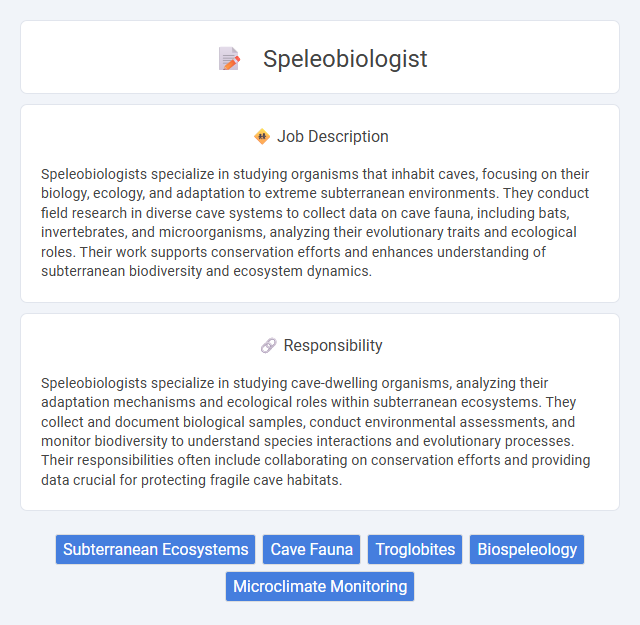
Speleobiologists specialize in studying organisms that inhabit caves, focusing on their biology, ecology, and adaptation to extreme subterranean environments. They conduct field research in diverse cave systems to collect data on cave fauna, including bats, invertebrates, and microorganisms, analyzing their evolutionary traits and ecological roles. Their work supports conservation efforts and enhances understanding of subterranean biodiversity and ecosystem dynamics.
Individuals with a strong sense of adventure and physical fitness are likely to find speleobiology appealing, as the job often involves exploring underground caves in challenging environments. Those who may be prone to claustrophobia, have respiratory issues, or prefer a stable office setting could find the conditions unsuitable for this profession. Passion for biology, patience, and adaptability might increase the probability of success and satisfaction in this career.
Qualification
Speleobiologists typically require a strong background in biology, ecology, or environmental science, often supported by a bachelor's or master's degree in these fields. Expertise in cave ecosystems, biodiversity, and species adaptation is essential, alongside skills in field research, data collection, and analysis within subterranean environments. Proficiency in spelunking and familiarity with scientific equipment for monitoring cave habitats further enhance qualification for this specialized role.
Responsibility
Speleobiologists specialize in studying cave-dwelling organisms, analyzing their adaptation mechanisms and ecological roles within subterranean ecosystems. They collect and document biological samples, conduct environmental assessments, and monitor biodiversity to understand species interactions and evolutionary processes. Their responsibilities often include collaborating on conservation efforts and providing data crucial for protecting fragile cave habitats.
Benefit
Speleobiologists likely benefit from exploring unique cave ecosystems, which may contribute to important scientific discoveries about biodiversity and evolutionary processes. This niche field could offer opportunities for interdisciplinary collaboration and specialized research funding. Career satisfaction may increase due to the potential impact on conservation efforts and the advancement of subterranean biology knowledge.
Challenge
Speleobiologists likely face the challenge of navigating hazardous cave environments while studying delicate ecosystems. The probability of encountering unpredictable conditions such as tight spaces and unstable terrain may require specialized training and careful preparation. Balancing scientific research with personal safety could be a constant and critical concern in this field.
Career Advancement
Speleobiologists specializing in cave ecosystems often advance their careers by pursuing advanced degrees in biology, ecology, or geology, enhancing their research skills in subterranean biodiversity. Progression typically involves leading field expeditions, publishing significant findings on cave-adapted species, and securing grants for conservation projects. Career growth can lead to positions in academia, environmental consulting, or governmental agencies focused on natural resource management and cave preservation.
Key Terms
Subterranean Ecosystems
Speleobiologists specialize in studying organisms inhabiting subterranean ecosystems, focusing on cave environments, groundwater systems, and underground habitats. They analyze biodiversity, species adaptations, and ecological interactions unique to darkness, stable temperatures, and nutrient-scarce conditions. Their research supports conservation efforts and enhances understanding of subterranean life's response to environmental changes.
Cave Fauna
Speleobiologists specialize in studying cave fauna, exploring unique ecosystems inhabited by troglobitic species adapted to complete darkness and nutrient-scarce environments. Their research involves documenting biodiversity, analyzing adaptations such as reduced pigmentation and eyesight, and assessing the ecological roles of cave-dwelling organisms like cavefish, bats, and invertebrates. By understanding these species, speleobiologists contribute to conservation efforts and help monitor environmental changes impacting subterranean habitats.
Troglobites
A speleobiologist specializes in studying troglobites, which are unique cave-dwelling organisms adapted to dark, nutrient-scarce environments. These specialists analyze the morphology, behavior, and genetic makeup of troglobitic species such as blind cave fish, cave crickets, and amphipods to understand evolutionary adaptations like loss of pigmentation and eyesight. Research on troglobites provides critical insights into subterranean ecosystem biodiversity and helps inform conservation strategies for vulnerable cave habitats.
Biospeleology
Speleobiologists specialize in biospeleology, the study of organisms that inhabit caves and other subterranean environments. They conduct research on cave ecosystems, examining how species adapt to extreme conditions such as darkness, limited nutrients, and high humidity. Their work contributes to understanding biodiversity, evolutionary biology, and conservation efforts related to fragile cave habitats.
Microclimate Monitoring
Speleobiologists specializing in microclimate monitoring study cave ecosystems by measuring temperature, humidity, and air flow to understand their impact on subterranean biodiversity. Precise data collection using advanced sensors helps assess environmental changes that affect cave-dwelling organisms, including rare and endemic species. This role involves integrating microclimate analysis with biological surveys to inform conservation strategies and habitat protection efforts.
 kuljobs.com
kuljobs.com